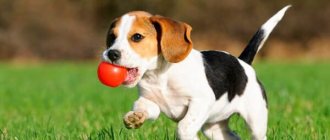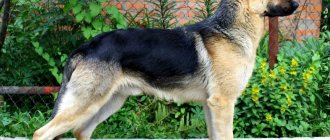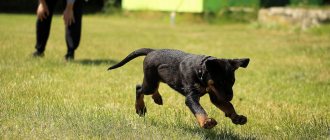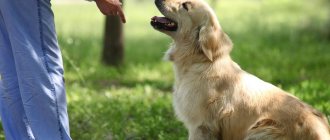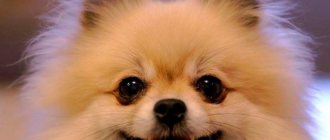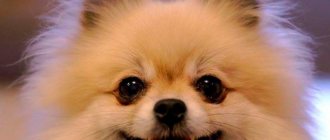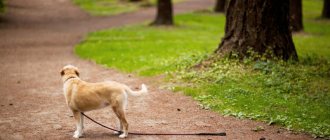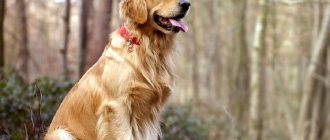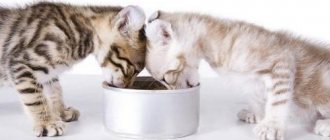- Dogs
Rottweilers are distinguished by their large size and overall massive build. The size and weight of a Rottweiler in the first months of life increases at a record rate. By the age of six months, the Rottweiler’s weight increases 10 times, and its height increases 3 times. With such size, the Rottweiler tends to consider itself superior to humans. Therefore, training such a dog is simply necessary.
Website about dogs
The Rottweiler is one of the most popular dog breeds in the world.
A reliable, incorruptible guard who is at the same time capable of the most tender affection for members of his human family, this dog requires a balanced approach when deciding to take a pet home. The Rottweiler is a serious dog that needs the same serious attitude from its owners.
In general, the Rottweiler is a fairly healthy dog, but there are still a few things that can develop into problems. Often these large, heavy dogs suffer from diseases and pathologies of the musculoskeletal system. To protect your pet from a similar fate, you should pay attention to its diet from puppyhood. It is better to feed a Rottweiler puppy with ready-made high-quality food such as Royal Canin dog food, choosing exactly the food that is designed for such dogs, taking into account the age of the puppy. This will allow him to create a complete diet containing all the necessary vitamins, minerals and nutrients responsible for the normal growth and development of the puppy.
It is important to never overfeed your dog - at any age. Pleading “hungry” eyes should not mislead you. If it is difficult for you to independently determine the dog’s condition, contact an experienced veterinarian who will tell you in which direction you need to adjust the diet so that it is optimal. Excess weight is unacceptable for a Rottweiler. This is an extra load on the heart and joints, and these are already not the strengths of these dogs.
Don’t feed your dog just anything - it’s better to stick to some good food and strictly follow the manufacturer’s dosage instructions. Royal Canin food is an excellent option for not having to think about whether you have chosen the right menu for your pet.
Like any other representative of the Molosser group, the Rottweiler is quite susceptible to infectious diseases.
It is mandatory that a Rottweiler puppy be vaccinated as a preventative measure - annually, with complex vaccines against distemper, enteritis, viral hepatitis, adenovirosis, leptospirosis and rabies. It is better to check the vaccination plan at your veterinary clinic. Do not forget to treat for parasites - worms - the day before, 10-14 days before any vaccinations.
The Rottweiler is a late maturing dog. Do not demand from him at 6 months the same agility as from a terrier - the Rottweiler is still “damp”, his backbone is forming, and he will still catch up with his own. But excessive load with jumping is now undesirable for him.
Be sure to treat your puppy and then your adult dog for ticks. Piroplasmosis is now widespread, and even city dogs that do not visit forests and fields suffer. This is the very case when it is better to be careful.
Required vaccinations
The innate immunity received by the puppy from its mother protects it from viruses and infections for 2-2.5 months. After this, the puppy requires vaccinations to help develop its own immunity.
Vaccination protects your dog from:
- plague;
- hepatitis A;
- rabies;
- leptospirosis;
- viral enteritis;
- adenovirus;
- parainfluenza.
NOTE!
You cannot vaccinate a puppy during illness, after a recent illness or during the period of teeth change, and before vaccination it is necessary to carry out deworming.
Vaccination and deworming schedule:
- 14-21 days – deworming;
- 4-5 weeks – 1 vaccination, DP -pappi;
- after 10 days – removal of worms;
- 7-8 weeks – 2 vaccinations, DHPPI+L;
- 10-11 weeks – 3 vaccinations, DHPPI+L;
- 14-15 weeks – deworming;
- 6 months – 4 vaccinations, DHPPI +L;
- 8 months – 5th vaccination, Nobivak Rabies rabies vaccine;
- 1 year – 6th vaccination, DHPPI+L.
DHPPI+L and rabies vaccinations must be repeated annually.
Upbringing
Rottweilers are smart and cunning in their own way. These dogs know how to observe and draw conclusions. You must be consistent and stubborn in achieving your goals while raising this dog, otherwise the little mouth, sensing weakness, will sit on your head and begin to command from there.
Start parenting as early as possible. Definitely - with obedience. The Rottweiler already has enough innate aggression; if desired, you can “format” it, directing it in the right direction. But in the initial stages, complete obedience must be achieved, otherwise problems cannot be avoided. This is not a pocket dog - it is a serious animal of decent weight, with a quick reaction and not very developed cordiality towards strangers.
When accustoming your puppy to its name, begin to teach it and come to you on command, rewarding it with treats and games. Then connect “sit”, “place”, “near”, “not allowed”. If desired and possible, it makes sense to go to a training ground (only with all vaccinations done!). This is useful for you as an owner, and good socialization for your pet.
Types of muzzles
This table lists the pros and cons of different types of muzzles:
| Type of muzzle | pros | Minuses |
| Plastic |
|
|
| Metal |
|
|
| Closed leather |
|
|
| Open leather |
|
|
| Nylon |
|
|
Feeding and caring for a Rottweiler puppy at home
A dog in the house is a source of not only joy, but also of great responsibility. Before getting a pet, you must first clearly understand the purpose of its presence in the house (for security, company, or other things), and also analyze the possibility of fulfilling your responsibilities to it (proper feeding, walking, training, and so on).
If you need reliable security, and at the same time pleasant dog company, then you can safely choose such a popular breed as the Rottweiler.
The Rottweiler amazes with its versatility. After all, with proper upbringing, he is able to simultaneously be a serious protector of the owner and an affectionate friend of the child.
There is still debate about the origin of these dogs, but there is a version that the ancestors of Rottweilers regularly served Roman society, in particular the legionnaires. Additionally, some experts tend to think that this breed is descended from the Tibetan Mastiff. One way or another, the small town of Rottwil in southern Germany is recognized as the homeland of Rottweilers .
Training at 3 months. Socialization
Three months is an important stage in a Rottweiler puppy’s introduction to the outside world. Your first walks should be short and not too tiring for the puppy. You should start with 15 minutes, gradually increasing the walking time to 1 hour.
Correct formation of the nervous system
At this age, the puppy’s nervous system is forming.
. It has been proven that raising puppies in isolation during this important period contributed to the development of pronounced cowardice in them later. It is necessary to show the puppy as much as possible: noisy streets, large crowds of people, etc. Everything that he will have to face in later life.
This must be done very carefully, gradually, over and over again increasing the time spent in noisy places, so as not to overload the puppy or frighten him.
The territory of a country house, cottage or village are places with a minimum amount of external stimuli for a city dog. Therefore, if you plan to keep a dog in an urban environment, “growing up” a Rottweiler puppy in such conditions depleted of irritants is unacceptable.
A city puppy must grow up in the city, in conditions that are saturated with external stimuli, such as: noisy streets, large crowds of people, other animals, birds, cyclists, cars, etc.
Meeting people and dogs
It is necessary to introduce the puppy to friendly dogs and people
so that later the puppy does not develop aggression or cowardice caused by the fear of new things and the inability to communicate and make new acquaintances. Currently, unfortunately, this is not uncommon in the behavior of adult dogs, but a fairly common problem with which people turn to our specialists for help.
Puppy behavior on the street
The emergence of new places leads to new rules that need to be consolidated:
- Now you can and should go to the toilet on the street, and not stoically endure it, carrying everything home;
- Not every new person or dog wants to communicate, so you don’t need to run headlong to meet everyone;
- Not all food is healthy, so it should only be taken from the owner’s hands.
Training and practicing commands
Training a puppy follows the same principles as at 2 months. It should be remembered that at this age puppies develop conditioned reflexes quite easily, but they are forgotten just as quickly, so you should not scold the puppy for not following commands, especially if they have not been repeated for a long time, but you should pay more attention to learning new things and repeating already covered material .
Brief description of the breed
The Rottweiler is a large breed. The weight of an adult dog is more than 42 kg, and its height ranges from 56-68 cm depending on the sex of the animal.
By all standards, the color of the dog should be black with red tan. Other options do not meet the breed requirements.
By nature, the Rottweiler is cunning, soft and affectionate; it is sometimes even compared to a cat, but only for members of its family. If he feels seriously threatened, he will turn into a ruthless protector of the pack (family).
Considering that the dog’s instinct to protect its owner comes first, it must be trained to avoid the manifestation of causeless aggression. The Rottweiler is easy to train, you just need to overcome its natural laziness. In addition to training, do not forget about the early socialization of the dog.
If a person does not have experience raising this type of dog, then they should entrust the dog to a professional or think about choosing a different breed.
Distinctive features
This breed is distributed throughout the world, which has made its own adjustments to the breed line. There are three main standards: German (truly correct Rottweilers), English (dogs with an imperturbable calm character), American (dogs with increased aggressiveness and the largest sizes).
The correct representative of the breed should be massive and strong. At the withers, dogs reach 60-70 cm and weigh about 50 kg . They do not look light or heavy, although they are large enough and can inspire fear.
The last standard was published in 2000. Breeders monitor the quality of the litter and disqualify all puppies that do not match the characteristics of appearance or temperament.
- The head is not heavy. The skull is long, convex with a pronounced occipital protuberance and brow ridges. A deep stop .
- The muzzle is of medium length, not too wide, tapering towards the nose. The bridge of the nose is straight and horizontal. Cheekbones are clearly visible . The jaws are very strong and wide with a full set of teeth. Scissor bite Lips are dense black.
- The nose is oval, large, black, with open nostrils.
- The eyes are small, almond-shaped, set at stop level. The color of the iris is dark brown.
- The ears are triangular in shape, small, hanging on cartilage, set above the eye line. Cupping for cosmetic purposes is permitted (prohibited in some countries);
- The body is powerful and streamlined. The back is straight and long. The loin is wide, the croup is sloping. The chest is voluminous, deep and wide. The stomach is not tucked in. The neck is of medium length with a convex scruff.
- The tail looks like an extension of the back, hangs in a calm state, reaches the hock joints, and is surrounded by hair. Cupping is allowed.
- The limbs are long, strong, straight, set wide. The feet are round with well-knit toes and strong pads. Movement : wide trot.
- The coat is short, thick, and harsh. The undercoat is shorter than the main coat, dense, retaining heat.
- The color is black with outlined red-red tan markings on the face, chest, paws, and at the base of the tail.
How to feed a Rottweiler correctly
A dog’s diet is the second important point after upbringing and training. How long Rottweilers live at home depends on the quality of the diet and the correct feeding regimen. And they live a long time: with good care, up to 12 years.
Basic feeding rules
Veterinarians and breeders advise following the following recommendations:
- A bowl of clean water should always be within the dog's reach.
- If food remains after eating, it must be removed. The next portion should be given at the next feeding time.
- You should not change the brand of food unless necessary. In case of allergies or food intolerance, new food should be introduced gradually, replacing some of the familiar food with new food.
Types of feed
The Rottweiler's diet should be varied. You can feed dry food or natural food:
- Dry food. The main advantages of industrial food are a balanced combination of ingredients and saving the owner’s time on preparing food for the dog. Food should be purchased at least premium. They are of higher quality compared to inexpensive analogues and can provide the Rottweiler with all the necessary nutrients for a full and healthy life.
- Natural food. The main part of the food is meat and offal. In addition to them, sources of protein for your pet can be fermented milk products, eggs, and low-fat fish. The Rottweiler gets carbohydrates from rice and buckwheat, and fiber from vegetables. Prohibited foods are sweets, milk, and tubular bones.
How to care for a Rottweiler puppy
Rottweilers are fairly large dog breeds. In order for a dog to grow up healthy and live for a long time, it is necessary to pay attention to its nutrition and physical activity from the very “childhood” age.
In addition to caring for the dog, the owner should try to adapt it as much as possible to life in the family, since the tendency to dominate is one of the main character traits of this breed. You will have to socialize your four-legged friend from the moment he is separated from his mother.
How to care for a Rottweiler and how to raise a four-legged friend are the main questions that concern novice dog breeders.
First lessons
Now let's move on to practice and talk about how to properly raise a Rottweiler. From the first day in your home, the puppy should become familiar with its name. This is the key to further achievements. Now we are gradually starting to practice basic obedience skills. Any time you are watching TV, cooking dinner, or watching your puppy frolic, call his name and give the command “Come.” You can lightly slap the leg so that the baby understands what is required of him. Now praise and release with the command “Walk”.
It is equally important to determine your dog's position. It should be comfortable and cozy. On the very first night, put a piece of diaper from the mother's nest into it and give the command “Place”. At first you will have to get up often to calm the baby, stroke it and give warm milk, but then repeat the command and go to bed. So, gradually, the baby develops an image of this world in which you are an adored master, whose word is the law.
Rottweiler - care and maintenance
One of the basic rules for caring for a Rottweiler is to constantly expose it to physical activity. This will help keep your dog in good shape. In addition, representatives of this breed themselves prefer an active lifestyle.
If your dog lives in an apartment, how can you ensure it is well cared for and active? There are several methods.
- Walk your Rottweiler in an area where he can run and play freely. This could be a designated area for walking dogs, a large park, or a vacant lot. For those who live outside the city, finding a piece of pristine nature is much easier.
- Take an active part in your pet's games. Of course, it is best to do this outside. Bring a ball or other toys designed for dogs. You can use “improvised” means. Any thick and short stick will do, so that your pet will enthusiastically chase it and bring it back, proudly laying it at your feet.
- Lucky are those dogs whose owner loves hunting. The Rottweiler will be an excellent assistant, as he will enjoy this activity. If the hunting season is not open, you can go photo hunting. The main thing is that there is a lot of movement and the dog can realize its needs for running.
Those who have got a dog for the first time are especially concerned about the question of how to care for its fur . Rottweilers do not need constant brushing. Only during molting they will have to be carefully combed. Especially if the pet lives in an apartment and not in an enclosure.
How to care for a Rottweiler puppy - health and nutrition features
Many large dogs, including Rottweilers, are at risk of developing osteochondrosis and arthrosis. In addition, with age, problems with the hip and elbow joint may appear. An adult dog can weigh about 50 kilograms. In just 12 months of its life, the puppy increases its body weight, increasing it 80 times.
In order for your baby’s musculoskeletal system to develop correctly, it is necessary to supply his body with useful elements׃
- glucosamine;
- fatty acids EPA and DHA;
- chondroitin.
This breed is predisposed to diseases such as
- diabetes;
- cataract;
- obesity;
- cardiological pathologies.
Proper nutrition can help relieve some health problems. Specialized food for puppies of this breed “Rottweiler Junior” will help the pet develop properly and receive all the necessary vitamins, fats, acids and minerals. When a dog turns 1.5 years old, it can be switched to dry food intended for an adult dog. For example, on Rottweiler Adult.
Why is this food useful?
- helps to avoid problems with joint diseases;
- keeps your pet in shape - prevents obesity;
- Constantly gnawing on croquettes increases the strength of teeth and gum health, and prevents the formation of tartar.
Rottweilers need large meals. In the first two months, the puppy should receive food several times a day. Then food intake is reduced to 3-4 times. An adult dog is transferred to two feedings a day.
If your pet eats dry food, you must adhere to the dosages indicated by the manufacturer on the packaging. While Rottweilers cannot be overfed, feeding them once a day is not acceptable.
Is it possible to keep a Rottweiler outside in winter?
This issue still remains unresolved. Some owners keep their dogs in a kennel all year round. Others argue that the Rottweiler has too little fur for him to survive the winter outside without problems.
If it is not possible to house your pet for the winter, make sure that its “wintering” is comfortable and safe. The kennel should be insulated as much as possible, and during severe frosts, figure out how to provide the “dog house” with additional heating. Otherwise, it is better to take your four-legged friend home for the night.
What age is best to start?
Puppy training begins at one month of age. Animals are first trained to:
- respond to nickname;
- use a special toilet;
- walk on a leash.
The puppy learns basic skills from its mother. When he is brought to another house, a person begins to be responsible for the fate of the baby. The Rottweiler performs its first commands from the age of two months. You cannot miss moments when your pet stops following orders.
From the very beginning, you need to prevent any antics of the puppy, from which bad habits can form:
- grab hands;
- show aggression towards family members;
- offend other animals.
Is it possible to keep a Rottweiler on a chain?
If you want to have a dog in your yard that will sit on a chain, it is better to get a “Caucasian” or a Moscow watchdog. The “specialization” of Rottweilers is like this
- watchman;
- bodyguard;
- guard;
- family companion;
- security guard.
This dog is not suitable as a chain watchdog. Caring for a Rottweiler involves giving your pet the opportunity to realize his potential and physical capabilities. This is a very good-natured family breed, but in case of danger that threatens the owner or his home, he becomes a formidable defender.
Protective guard service
Raising an independent and obedient dog is not an easy task, especially if it is a Rottweiler. Raising a puppy for protective guard duty is an even more difficult task. That is why it is carried out by professional dog handlers.
A cross between a shepherd and a Rottweiler (Malchover): description of the breed
All training is aimed at developing the necessary skills, including security, protection, the ability to look for a trace, etc.
Note! Few people need such courses in everyday life, so these skills are not taught to domestic dogs. If the owner tries to do this on his own, most likely, he will not succeed, but the dog’s psyche will be undermined.

